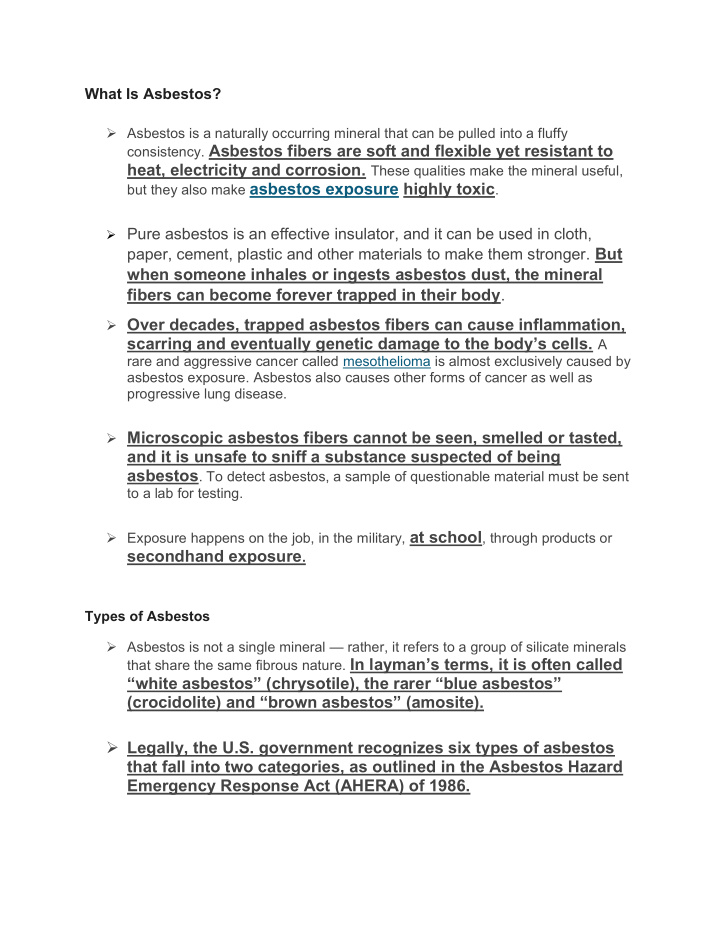



What Is Asbestos? Asbestos is a naturally occurring mineral that can be pulled into a fluffy consistency. Asbestos fibers are soft and flexible yet resistant to heat, electricity and corrosion. These qualities make the mineral useful, but they also make asbestos exposure highly toxic . Pure asbestos is an effective insulator, and it can be used in cloth, paper, cement, plastic and other materials to make them stronger. But when someone inhales or ingests asbestos dust, the mineral fibers can become forever trapped in their body . Over decades, trapped asbestos fibers can cause inflammation, scarring and eventually genetic damage to the body’s cells. A rare and aggressive cancer called mesothelioma is almost exclusively caused by asbestos exposure. Asbestos also causes other forms of cancer as well as progressive lung disease. Microscopic asbestos fibers cannot be seen, smelled or tasted, and it is unsafe to sniff a substance suspected of being asbestos . To detect asbestos, a sample of questionable material must be sent to a lab for testing. Exposure happens on the job, in the military, at school , through products or secondhand exposure . Types of Asbestos Asbestos is not a single mineral — rather, it refers to a group of silicate minerals that share the same fibrous nature. In layman’s terms, it is often called “white asbestos” (chrysotile), the rarer “blue asbestos” (crocidolite) and “brown asbestos” (amosite). Legally, the U.S. government recognizes six types of asbestos that fall into two categories, as outlined in the Asbestos Hazard Emergency Response Act (AHERA) of 1986.
In the decades since AHERA was passed, though, every further attempt to regulate asbestos in the U.S. has failed due to pressure from business interests . Asbestos Exposure Risks No amount of asbestos exposure is safe, but asbestos generally has the worst effects when a person is exposed to an intense concentration of it, or they are exposed on a regular basis over a long period of time . More asbestos accumulates in the body with every exposure, and there is no known way to reverse the cellular damage it causes. Asbestos materials fall into two risk categories: Friable asbestos materials are easy to break or crumble by hand. Examples include old asbestos pipe insulation and talcum powder contaminated with asbestos. These materials are dangerous because they can easily release toxic dust into the air. Nonfriable asbestos materials are durable. Examples include asbestos cement slabs and vinyl asbestos tiles. These products keep asbestos fibers safely trapped as long as the products are undisturbed. But it is always dangerous to smash, saw, or scrape asbestos-contain materials. Is Asbestos Banned? Asbestos is banned in most developed nations, including Japan and the countries of the European Union. But the toxic mineral is still commonly used in countries such as Russia, China, India and Mexico. In the United States, asbestos is not banned, but it is highly regulated.
At the end of 2019, the EPA is expected to finish its latest risk assessment of asbestos and determine whether to fully ban asbestos products in the United States. When Americans are exposed to asbestos today, it is usually through renovation or demolition work on an old building that still contains legacy asbestos products. Around the world, though, millions of people are still exposed to asbestos from mines, factories and construction sites. The asbestos industry has powerful lobbying organizations protecting its interests. PUBLIC AND CHARTER SCHOOLS IN NB DISTRICT #36 Ka Waihona O Ka Na’auao Public Charter School o Moved into the previous ocean-side campus buildings of Nanaikapono Elementary School in August 2004. o Nanaikapono Elementary School ocean-side campus opened in 1933 Nanaikapono Elementary School current mauka campus opened in July 2004. Nanakuli Elementary School opened in 1977 Nanakuli High & Intermediate School opened in 1967 Maili Elementary School opened in 1963
Recommend
More recommend